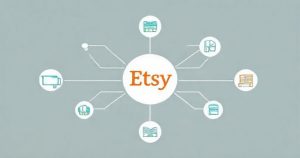In the vibrant and competitive world of online marketplaces, Etsy stands out as a unique platform for creators and entrepreneurs. To truly thrive and scale an Etsy business, sellers often find themselves navigating a complex web of tasks, from inventory management to shipping and accounting. The key to overcoming these challenges and maximizing efficiency lies in strategic Etsy integrations. These powerful tools seamlessly connect your shop with various external services, automating tedious processes and freeing up valuable time for creativity and business development.
Understanding Etsy Integrations: Tools for Streamlined Selling
Etsy integrations are third-party applications or services designed to connect directly with your Etsy shop’s data. They facilitate a smooth flow of information between your store and other essential business functions, such as shipping carriers, accounting software, inventory management systems, and even marketing tools. This connectivity transforms manual, time-consuming operations into automated workflows, allowing sellers to manage their business more effectively.
The core purpose of these integrations is to enhance productivity and reduce the likelihood of human error. By linking disparate systems, sellers can ensure consistency across their operations, whether it involves updating stock levels after a sale or accurately recording transactions for tax purposes. Embracing Etsy integrations is a proactive step towards building a more robust and scalable online presence.
Enhancing Shipping Efficiency with Dedicated Platforms
One of the most critical aspects of any e-commerce business is efficient shipping, and Etsy integrations offer significant advantages here. Dedicated shipping platforms integrate directly with your Etsy orders, allowing you to import order details, compare carrier rates, print shipping labels, and manage tracking information from a single dashboard. This streamlined process eliminates manual data entry, reducing errors and saving considerable time for high-volume sellers.
Such integrations often provide access to discounted shipping rates, which can significantly impact profitability. They also automate sending tracking updates to customers, enhancing the post-purchase experience and reducing customer inquiries. For sellers handling diverse product types or international shipments, these tools simplify customs forms and complex logistics, ensuring smooth delivery and customer satisfaction.
Mastering Inventory and Order Synchronization
Maintaining accurate inventory levels is paramount for preventing overselling and managing customer expectations. Etsy inventory management integrations offer real-time synchronization across various sales channels, including your Etsy shop and potentially other platforms. When an item sells on Etsy, the inventory count automatically updates everywhere else, providing a consolidated view of your stock.
These tools extend beyond simple stock tracking to encompass comprehensive order management. They help organize incoming orders, track their status from processing to fulfillment, and provide insights into best-selling products. By centralizing order data, sellers can efficiently process multiple orders, prioritize urgent shipments, and ensure every customer receives their purchase promptly and correctly.
Simplifying Financial Management with Accounting Software Links
Accurate bookkeeping and financial tracking are essential for understanding your business’s health and preparing for tax season. Etsy accounting integrations bridge the gap between your sales data and your financial records. They automatically import Etsy sales, fees, and expenses into popular accounting software, removing the need for manual data entry and reconciliation.
This automation ensures that your financial statements are always up-to-date and accurate, providing clear insights into your revenue, costs, and overall profitability. Sellers can easily generate reports for tax purposes, monitor cash flow, and make informed financial decisions. The time saved on manual accounting tasks can be redirected towards growing the business and developing new products.
Leveraging Print-on-Demand and Dropshipping Connections
For sellers utilizing print-on-demand (POD) or dropshipping models, seamless Etsy integrations are non-negotiable. These integrations connect your Etsy shop directly with POD providers or dropshipping suppliers. When a customer places an order on your Etsy store, the integration automatically sends the order details to the supplier, who then prints, packages, and ships the product directly to the customer.
This automated workflow eliminates the need for sellers to manage inventory, production, or fulfillment themselves, allowing them to focus purely on design, marketing, and customer service. It enables a highly scalable business model with minimal upfront investment and significantly reduced operational overhead. Products types can range from apparel to home decor, all managed through these crucial integrations.
Strategic Selection of Etsy Integration Solutions
Choosing the right Etsy integrations involves a careful assessment of your specific business needs and goals. Consider the volume of your sales, the complexity of your product catalog, and the amount of manual work you currently perform. Evaluate integrations based on their compatibility with your existing tools, ease of use, cost-effectiveness, and the level of support offered.
Many integration solutions offer free trials, allowing sellers to test their features before committing. Prioritize integrations that address your most significant pain points, such as slow shipping processes or convoluted accounting. A well-chosen suite of Etsy integrations can transform your operational efficiency, paving the way for sustainable growth and a more enjoyable selling experience.
The Transformative Impact of Integrated Etsy Workflows
The strategic implementation of Etsy integrations offers a profound impact on the trajectory of an online business. By automating repetitive tasks, sellers gain invaluable time that can be reinvested into product development, marketing campaigns, and enhancing customer relationships. This shift from operational burden to strategic focus is crucial for staying competitive and expanding market reach.
Ultimately, integrations lead to improved customer satisfaction through faster order processing, accurate inventory, and timely communication. They provide the necessary infrastructure for scaling operations without a proportional increase in manual workload. Investing in the right Etsy integrations is not merely about convenience; it is about building a resilient, efficient, and profitable Etsy business ready for future success.





